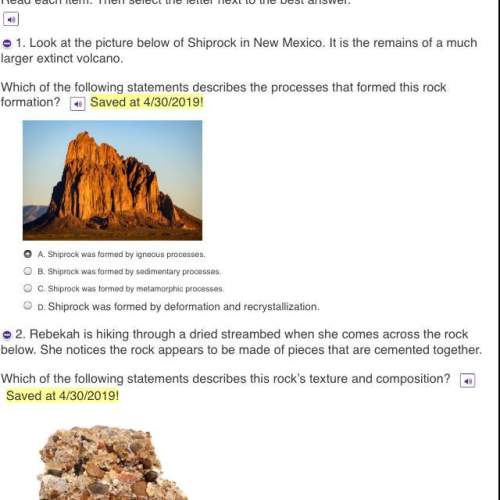
Biology, 26.07.2019 21:30 mpjoserivera
On a field trip, your science teacher, mrs. waters, pointed to ground water coming to the surface and identified it as a geyser. she said groundwater was forced above ground by an increase in pressure, but you see no steam or boiling water. what did she really describe? a.) an artesian well b.) a lake c.) mrs. waters is right, she described a geyser d.) a spring

Answers: 1
Another question on Biology

Biology, 21.06.2019 21:00
1. environmental factors, such as ph and temperature, can affect the function of an enzyme. a. true b. false 2. which of the following is an organic molecules (ex. vitamins) that an enzyme? a. coenzyme b. product c. active site d. substrate 3. how do enzymes effect the speed of a chemical reaction? a. they speed it up b. they slow it down c. they have no effect on the speed of a reaction 4. during a chemical reaction, an enzyme is used up so that it can only be used one time. a. true b. false 5. which of the following results from a chemical reaction that is catalyzed by an enzymes? a. active site b. product c. substrate d. coenzyme
Answers: 3

Biology, 22.06.2019 05:50
Below are the three main organs that make up the plant body. what is the main function of the structure that is identified as b in the picture above? it anchors the plant.it produces food.it absorbs nutrients.it supports the plan
Answers: 1

Biology, 22.06.2019 06:40
Which of these has happened to your food by the time it reaches your small intestine? a. all the macromolecules have been broken down completely. b. lipids and starches have been partially broken down. c. starches and proteins have been partially broken down. d. proteins and lipids have been broken down into subunits.
Answers: 3

Biology, 22.06.2019 06:50
The kidney filters potentially toxic substances in the blood, and thus “clears” the blood of those substances. this clearance function is dependent upon and proportional to the diffusion gradient of the substance across filtering capillaries, i.e. if the concentration of the substance is doubled, twice as much will be cleared from each ml of blood that is filtered. suppose that the body produces a constant amount of a substance x per unit of time. the kidneys eliminate substance x at a rate directly proportional to the concentration of the substance and the volume of blood cleared each minute (c): elimination = c × [x], where [x] is the steady-state concentration of substance x. imagine an individual with an initial concentration of x equal to [x]0 who develops kidney disease. her baseline clearance c0 drops to one half of the original (½c0). what is the new steady state concentration of x? (for simplicity, assume that substance x is 100% filtered by the kidney).
Answers: 1
You know the right answer?
On a field trip, your science teacher, mrs. waters, pointed to ground water coming to the surface an...
Questions

English, 20.05.2020 22:02

Mathematics, 20.05.2020 22:02

Mathematics, 20.05.2020 22:02


History, 20.05.2020 22:02

Mathematics, 20.05.2020 22:02

History, 20.05.2020 22:02

Health, 20.05.2020 22:02

Mathematics, 20.05.2020 22:02




Mathematics, 20.05.2020 22:02




Mathematics, 20.05.2020 22:02


Geography, 20.05.2020 22:02




